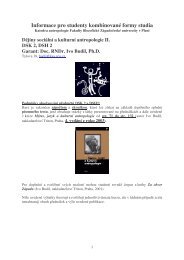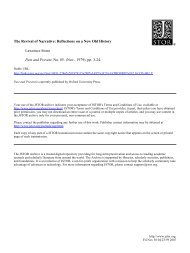BOB SCRIBNER Historical Anthropology of Early Modern Europe
BOB SCRIBNER Historical Anthropology of Early Modern Europe
BOB SCRIBNER Historical Anthropology of Early Modern Europe
Create successful ePaper yourself
Turn your PDF publications into a flip-book with our unique Google optimized e-Paper software.
22 Bob Scribnerweather or simply future events 21 . Now in none <strong>of</strong> this is there any referenceto cats as symbols <strong>of</strong> sexuality and Darnton's arbitrary application<strong>of</strong> this particular symbol has a decidedly freudian ring to it 22 .The example raises some very acute questions about both methods andsources for the historian who wishes to engage in historical anthropology.The first issue <strong>of</strong> method is how far one can take over anthropologicaltheories uncritically, without reflection on the appropriate modificationsrequired for the historian's period or subject. Anthropologists are wellaware that the same method and conceptualisation that might apply toAfrican tribal societies cannot be simply transferred to Latin-Americanpeasant societies. But the problem has become more complicated thanthat through the growing awareness in the discipline during the 1980s <strong>of</strong>how anthropology constructs its subject from a very particular point <strong>of</strong>view, namely from <strong>of</strong> white, male, middle-class Western observers. Thisperception is certainly not new and was raised as a decisive objection inan important debate <strong>of</strong> the early 1960s over attempts to distinguish analyticallybetween religion and magic 23 . Anthropologists are now rethinkingnot only their methods, but even the very basis <strong>of</strong> their discipline, andthis certainly means that the historian cannot simply turn to anthropologyfor methodological or even conceptual guidance without a good deal <strong>of</strong>reflection on the status and the validity <strong>of</strong> the method to which he orshe feels attracted.There is a further more specific problem <strong>of</strong> method.It is usually saidthat the difference between the anthropologist and the historian is that theformer can interrogate his or her subjects in fieldwork and so arrive at21 H. Bachthold-Staubli, Handworterbuch des deutschen Aberglaubens, vol. 4 (Berlin,1932), 1107- 1124.22 It is interesting and perhaps informative about Darnton's mode <strong>of</strong> argument by association that the first edition <strong>of</strong> the volume (as does the German edition) contained apiece <strong>of</strong> extremely misleading 'visual evidence', a reproduction <strong>of</strong> a sketch for Manet's provocative Olympia, in which a cat stretches itself along the buttocks <strong>of</strong> the reclining nude. The date <strong>of</strong> this work from the 1850s is some two generations after thestory in question, as is the reproduction <strong>of</strong> Antoine Wiertz's 1850 depiction <strong>of</strong> 'ayoung witch 1 . Darnton seems to share with Geertz a preference for the imagery <strong>of</strong>the sexually-liberated 1960s, which it has been argued influenced Geertz's choice <strong>of</strong>language and metaphor in his analysis <strong>of</strong> the Balinese cockfight, see Vincent Crapanzo,Hermes' Dilemma and Hamlet's Desire. On the Epistemology <strong>of</strong> Interpretation (Cambridge, Mass., 1992), pp. 60 - 69.23 Murray and Rosalie Wax, 'The Notion <strong>of</strong> Magic', Current <strong>Anthropology</strong> 4 (1963),495-518.







